As we all know it, Turnitin easily detects tools like Quillbot and Wordtune – so the big question is; can it also detect Deepseek? The short answer is YES. The longer answer though, lies in the details. Keep reading to know more about it.
How Turnitin Works?
Turnitin’s AI detection system is a sophisticated piece of software that uses natural language processing (NLP), stylometric analysis and machine learning models that are trained on huge amounts of data to flag content that looks too “perfect” or too AI-generated.
In simple terms, Turnitin’s classifiers are built by training on labeled data – machine generated vs human written – so they can pick up on patterns like low perplexity, minimal burstiness and overly consistent grammar. Although its detection system is not flawless and is riddled with false-positives at times, Turnitin can easily incorporate outputs from AI models, like Deepseek R1 or V3, into their training data.
By continually retraining their classifier with new data, Turnitin remains one step ahead – if you haven’t used any special prompts to bypass it, Deepseek’s text is likely to get flagged.
How Deepseek R1 Works?
Deepseek R1 is a state-of-the-art large language model (LLM) that’s built with many of the same techniques used by its competitors, like ChatGPT.
In fact, if you read Deepseek’s paper, they themselves claim that they have leveraged outputs from frontier models such as ChatGPT, Claude, and Gemini to train their models. That means AI generated text – from all these different models – is in its training samples.
Deepseek uses novel, extremely cost-efficient techniques to train its models (hence the hype), but at the end of the day, it is still an LLM that produces text based on learned patterns.
Thus, if you believe that output from ChatGPT or other similar models could be detected by Turnitin, then what makes Deepseek any different? Simply put, unless you use special prompts or methods to deliberately mask Deepseek’s fingerprint, Turnitin will spot it just as easily as any other AI tool.
Ways to Bypass Turnitin’s AI Detector
If you’re aiming to dodge Turnitin’s AI detection, here are some techniques that people have been trying – but use them with caution because nothing is foolproof:
1. Play with the Punctuations and Grammar
Tweak your punctuation intentionally – avoid tools like Grammarly which will automatically correct your deliberate errors. Experiment with the Oxford comma, semicolons versus colons, and random placement of quotation marks. The idea here is to create unpredictable patterns that don’t match the typical “perfect” style of AI generated text.
2. Modify Your Writing Style
Instead of simply relying on AI output from Deepseek, try altering your sentence structures. Mix in some shorter and some longer sentences, and don’t be afraid to let a few grammatical mistakes slip through. This can help mimic the irregular patterns of human writing and lower the explicit markers that Turnitin’s algorithms tend to look for.
3. Use an AI Text Humanizer
Tools like Deceptioner work as AI text humanizers. They take the generated text and rewrite it to sound more natural – complete with occasional errors and varied sentence rhythms. This approach is one of the fastest (albeit not always the most cost-effective) ways to get around Turnitin’s stringent detection methods.
4. Follow a Consistent Citation Style
Incorporating citations properly (APA, MLA, Chicago, etc.) can sometimes confuse the detector as it’s an indicator of human research behavior. Be cautious not to overdo it, though, as too many citations might prompt manual reviews by your instructor.
5. Be Mindful of AI’s Hallmarks
Since AI tends to use very formal language with flawless grammar, deliberately inject minor inconsistencies – mix active with passive voice, include personal opinions, or add occasional redundant phrases to create that human touch.
Pros and Cons of Turnitin’s AI Detection Capabilities
Below is an HTML table summarizing some of the advantages and disadvantages associated with Turnitin’s AI detection:
| Component | Pros | Cons |
|---|---|---|
| Plagiarism Detection | Highly effective at matching text to a vast database; well-established technology. | May flag even properly cited or rephrased work; prone to false-positives. |
| AI Text Analysis | Utilizes advanced machine learning models for subtle pattern detection; continuously updated training data. | Can misinterpret stylistic choices; sometimes flags completely human-written text wrongly. |
| Classifier Training | Constantly retrains using latest frontier AI outputs, making it robust to new methods. | Relies on standardized writing patterns which may miss innovative bypass techniques. |
| Adaptability | Regular updates and improvements in detection capabilities. | An ongoing cat-and-mouse game – as detection improves, bypass techniques evolve too. |
Frequently Asked Questions
Q1. Does Turnitin detect Deepseek?
Yes, Turnitin can easily detect Deepseek if you haven’t employed any special prompts or rewriting techniques. Their classifier can include Deepseek outputs from versions like R1 or V3 in its training data, making detection almost inevitable.
Q2. Is using Deepseek the same as plagiarizing?
No, using Deepseek isn’t plagiarism per se. The problem lies in the AI detection: if your work is flagged as heavily AI-generated, it might trigger additional review—even if you have used Deepseek to help polish your ideas.
Q3. Are AI text humanizers like Deceptioner effective?
They can be, as they help rephrase text to sound more human. However, be aware that while they reduce the chance of Flagging, none of these methods are completely foolproof in bypassing Turnitin’s continually evolving algorithms.
Q4. What makes Deepseek different from ChatGPT or Claude?
Deepseek leverages similar foundational techniques as its competitors. In its own paper, Deepseek mentions using outputs from ChatGPT, Claude, Gemini, among others. Essentially, if models like ChatGPT are detectable, then so is Deepseek – unless additional humanizing techniques are applied.
The Bottom Line
Deepseek’s AI models are impressive and cost-efficient, but they aren’t built with the purpose of bypassing AI detectors like Turnitin. If you rely solely on its output without making further adjustments, you’re likely to get flagged. Turnitin’s sophisticated classifier not only detects copied content but learns from every piece of text it encounters, meaning that any pattern typical of an AI – Deepseek included – gets scrutinized. While methods like tweaking punctuation, modifying your writing style, or using AI text humanizers such as Deceptioner can help lower the risk a bit, the truth is that the cat-and-mouse game between AI detection and bypassing techniques is only going to get more challenging over time.
At the end of the day, both ChatGPT and Deepseek are built on similar AI principles. So if you want your work to fly under the radar, you gotta blend your genuine writing with some smart humanizing tweaks rather than relying solely on any one AI tool. Happy writing, and proceed with caution!


![[HOT TAKE] Why is ZeroGPT so bad?](/static/images/why-is-zerogpt-so-badpng.webp)
![[DIRECT] Best Affordable AI Humanizers (That Still Work in 2025)](/static/images/best-affordable-ai-humanizerspng.webp)
![[HOT] Can You Compare ZeroGPT With Other Top Tools?](/static/images/can-you-compare-zerogpt-with-other-top-toolspng.webp)
![[HOT] Is JustDone AI Detector Accurate?](/static/images/is-justdone-ai-detector-accuratepng.webp)





